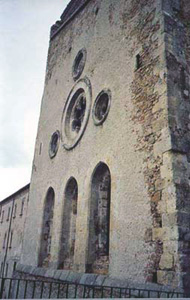An introduction and a poem about San Giovanni in Fiore
San Giovanni in Fiore in the fog...
[...] The insufficient afternoon light and the first autumnal dense fog imposed this feeling on the conscience, and they worried it. - by Salvatore Inglese
My
Hometown
-
by Rina Ferrarelli - A poem about San Giovanni in Fiore
San Giovanni in Fiore (1050 mt. about sea level) is a small medieval town in the Sila mountain range in Calabria. It has a population of 20.000, but half of them have emigrated to other places.
When and who founded San Giovanni in Fiore
San Giovanni in Fiore was founded in the XIII century around the Florens Abbey which was built by Gioacchino da Fiore, a medieval mystic and Cistercian monk, who wrote a lot of books about the prophecy of the salvation of the human race; for which he was very renowend even that time. Dante in the Divine Comedy decribed him as one "endowend whith prophetic spirit".

Photography by Giuseppe De Marco, 2003
Why did Gioacchino build the Abbey
Gioacchino da Fiore decided to dedicate himself to Biblical study, in particular the hidden meaning of the Scriptures. He proposed the creation of a new and stricter order which was called Florens after the name of the place where he believed the salvation of the human race would start. Pope Celestine III approved his proposal and so they started building the Abbey in 1198 in Sila.
San Giovanni in Fiore today
In the poem My Hometown Rina Ferrarelli describes the nostalgia she feels for the hometown and her pride in her roots, also she talks about how the old town is full of unused empty houses which were built by past generations of people from San Giovanni in Fiore for their children, but their children have never come back to San Giovanni in Fiore to live in these houses.
In the first chapter of the essay of "The restless alliance between psychopathology andanthropology (memories and reflections of an experience on the field)" - drawn of the "I fogli di Oriss", N 1, on 1993 - the Dr. Salvatore INGLESE wrote: My first impression was that of a place contained on him self, wrapped around an invisible, monastic and claustrophobic secret.
I don't see a positive future for San Giovanni in Fiore unless there a change of political class and the development of the tourist industry.
Beyond the goldsmith tradition, in the course of the History, the woven is the one that characterized the handicraft production of San Giovanni in Fiore, with bedspreads and trousseaus with strongly coloured geometrical motifs, some directly inspired by those of the hellenic colonists who in their turn had been instructed by Persian craftsmen. Itís useless to say that, beyond small sporadic examples, currently this tradition is practically extinct.
Despite its rich history and natural beauty San Giovanni in Fiore today is in a state of economic and cultural ruin, because of mass emigration, political degradation and the failure of traditional culture.
Francesco Saverio Alessio

My Hometown
The old medieval town
on a steep mountainside
which boasts as its founder
Joachim of Fiore
ďdi spirito profetico dotatoĒ
whom Dante put in the Paradiso
stayed the same until WWII
surviving it unscathed,
but now, even here,
narrow three story houses
fill every vacant space
and every garden
every single one
has been paved
made into a road or parking lot.
Whatís amazing, though,
is not the greed
or the need to take part
in the twentieth century,
but the trust,
the confidence in the future.
The wars are forgotten,
the hunger, i padroni.
Maybe for the first time in history,
even here itís America.
Rina FERRARELLI
Rina Ferrarelli was born in San Giovanni in Fiore but she emigrated to USA vhen she was fifteen.
She has published a chapbook, Dreamsearch (Malafemmina Press, 1992), and a full-length book oforiginal poems, Home Is a Foreign Country (Eadmer Press, 1996); her translation Light without Motionreceived the Italo Calvino Prize. Her work has also appeared in many journals and anthologies,including American Sports Poems (Orchard Books, 1988), Artful Dodge, Chelsea, Hudson Review, and International Quarterly. She teaches English and translation theory at the University of Pittsburgh.